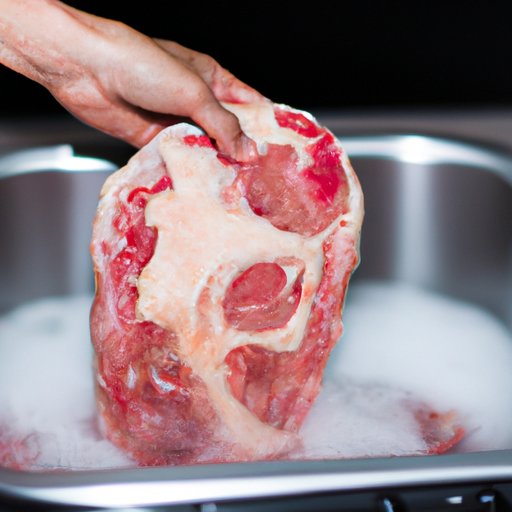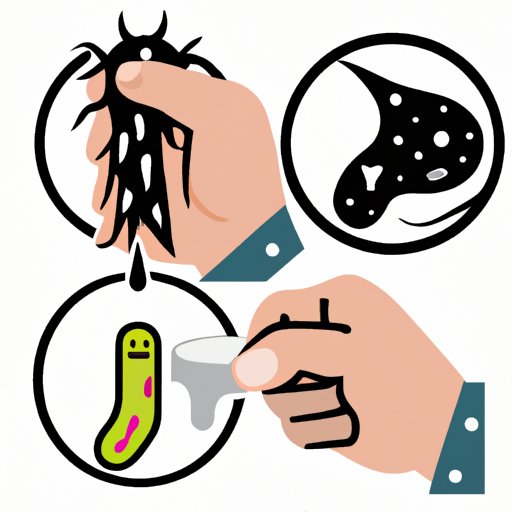I. Introduction
E. coli is a bacteria that naturally occurs in the intestines of humans and other animals. While some strains of E. coli are harmless, others can cause severe illnesses, including diarrhea and kidney failure. Understanding how E. coli is transmitted is critical in preventing infection.
II. Understanding the Basics of E. Coli and How it is Transmitted
E. coli is a gram-negative, rod-shaped bacterium that is found in the environment, food, and the intestines of animals and humans. While some strains of E. coli are harmless, others can cause illness in humans, which is known as a pathogenic E. coli. E. coli is transmitted via the fecal-oral route, usually from contaminated food or water. E. coli can also be spread via person-to-person contact.
III. The Most Common Sources of E. Coli Contamination in Food and Water
The following are the most common sources of E. coli contamination in food and water:
A. Contaminated Foods
1. Meat Products
E. coli is often found in the intestines of cattle and other livestock. Contaminated meat can spread the bacteria to humans through improper cooking or handling. Raw or undercooked ground beef is a significant source of E. coli infection.
2. Dairy Products
E. coli can spread to dairy products like milk and cheese if contaminated with fecal matter. Unpasteurized milk and cheese can be a significant cause of E. coli infection.
3. Fresh Produce
E. coli can also contaminate fresh fruits and vegetables, especially those grown in contaminated soil or irrigated with contaminated water. Raw spinach, lettuce, and sprouts are typically involved in E. coli outbreaks.
B. Contaminated Water
1. Drinking Water
E. coli can also spread through contaminated drinking water, especially in rural areas where water treatment may not be adequate. Contamination can occur through fecal matter or runoff from animal manure.
2. Recreational Water
Swimming and other recreational activities in contaminated water can also cause E. coli infection. This includes lakes, rivers, and recreational pools.

IV. The Risks Associated with Consuming Undercooked Meats and Unpasteurized Dairy Products
A. Explanation of Undercooked Meat and Unpasteurized Dairy Products
Consuming undercooked meats and unpasteurized dairy products can put individuals at risk for E. coli infection. Undercooked meats, such as ground beef, can still contain harmful E. coli bacteria, while unpasteurized dairy products such as raw milk may contain pathogenic E. coli that can cause adverse health effects in humans.
B. Effects of Consuming Undercooked Meat and Unpasteurized Dairy Products
Consuming undercooked meats and unpasteurized dairy products can cause symptoms like diarrhea, abdominal cramps, and vomiting. In severe cases, the infection can cause kidney failure and even death.
C. Prevention of E. Coli from Undercooked Meats and Unpasteurized Dairy Products
Proper cooking and heating of meat, as well as the pasteurization of dairy products, can kill harmful E. coli bacteria. It is also essential to practice good hygiene when handling and preparing these items.
V. The Importance of Proper Handwashing and Hygiene in Preventing E. Coli Infection
A. Explanation of How E. Coli Spreads Through Contaminated Hands
E. coli can easily spread from person to person through contaminated hands. This is especially true for infants and young children who are still learning proper hygiene practices.
B. Proper Handwashing Techniques to Prevent E. Coli Infection
Proper handwashing is essential in preventing E. coli infection. Hands should be washed with soap and water for at least 20 seconds, especially after using the toilet, changing a diaper, or working with raw meat or poultry.
C. Other Hygiene Practices to Prevent E. Coli Infection
Other hygiene practices, such as avoiding sharing utensils, wiping down shared equipment, and keeping surfaces clean, can also help prevent the spread of E. coli.
VI. The Risk of Exposure to E. Coli in Animal Environments, Such as Petting Zoos and Farms
People who work with animals or visit animal environments, such as petting zoos and farms, are at risk of exposure to E. coli.
A. Explanation of How Animals Can Be a Source of E. Coli Infection
Animals can carry E. coli bacteria in their intestines without getting sick. While harmless to the animal, it can cause severe infection in humans if ingested.
B. Risks of Exposure to E. Coli in Animal Environments
Handling animals and their feces can put individuals at risk for E. coli infection. This includes petting zoos, farms, and even handling household pets.
C. Prevention of E. Coli Infection from Animal Environments
Preventing E. coli in animal environments involves proper handwashing after handling animals or their feces and avoiding contact with any surfaces or objects that may have been contaminated.
VII. How E. Coli Outbreaks are Traced and Managed by Public Health Officials
Public health officials play a critical role in managing E. coli outbreaks. They work to identify the source of the outbreak and take measures to control the spread of infection.
A. Explanation of How E. Coli Outbreaks are Detected and Traced
When an outbreak of E. coli occurs, public health officials work to identify the source of the outbreak and track down any other potential cases. This often involves detailed investigations into the foods or environments that may have caused the outbreak.
B. Role of Public Health Officials in Managing E. Coli Outbreaks
During an E. coli outbreak, public health officials work to control the spread of the bacteria and prevent further infections. This may involve closing restaurants or other facilities, issuing public health notices, and advising individuals to seek medical attention if they experience symptoms of infection.
C. Measures Taken to Control E. Coli Outbreaks
Common measures taken to control E. coli outbreaks include temporary closure of suspected restaurants or facilities, removing contaminated products from the market, and issuing public health notices to inform the public of the risks associated with E. coli infection.
VIII. Tips for Staying Safe and Preventing E. Coli Infection in Your Daily Life
There are several things individuals can do to prevent E. coli infection in their daily lives.
A. Food Safety Tips
• Cook meat and poultry thoroughly
• Avoid cross-contamination when handling raw food
• Drink pasteurized milk and juices
B. Water Safety Tips
• Drink only safe water
• Boil water before drinking if unsure of the safety
• Avoid swimming in contaminated water
C. Hygiene Tips
• Wash hands thoroughly and frequently
• Practice good hygiene when handling animals
• Use hand sanitizer when soap and water are not available
D. Travel Tips
• Drink bottled water
• Avoid uncooked or undercooked food
• Practice good hand hygiene
IX. Conclusion
E. coli is a bacteria that can cause severe illness in humans. Understanding how it is transmitted is essential in preventing infection. By following proper handwashing techniques, practicing good hygiene and safety habits, and being aware of the risks associated with certain foods and environments, individuals can take steps to protect themselves from E. coli infection.
